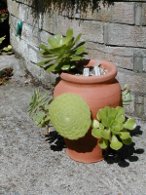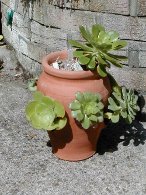2001:
We planted our first collection in a herb pot. This needed two photos to show it − Barum doesn't possess a camera that can track round the circumference.

This page captures the adventures of the Greenhouse Bed, where we have been trying to grow Succulents and other delicate plants.
In common with everyone else we already had some Agaves, but then we discovered Aeoniums during our first visit to The Canary Islands in 2000. That explains why it took several years before the bed and succulents get them selves connected.
Larger pictures are available at the click of a mouse hovered over the thumbnails.
2001:We planted our first collection in a herb pot. This needed two photos to show it − Barum doesn't possess a camera that can track round the circumference. |
 |
 |
2002:The Aeonium tabuliform decided to flower, and succumbed. We failed to get any of the seeds to germinate. We have since managed to replace it, but they're not easy to find.The paving, round the Greenhouse bed, began to be replaced, as described in the history of this year. "What's that got to do with succulents?" I hear you mutter. "Patience", I say to you. |
Winter 2004-05:This winter was fairly mild, minimum temp −3°C.The potted plants were overwintered in the greenhouse, along with the smaller plants that could reasonably be lifted. Those that could not easily be lifted remained in the ground. These were protected by a huge cloche made from some redundant sheets of polycarbonate roofing. More than half survived. |
2005:Following our success, more Aeoniums were planted directly into the soil, together with an Aloe ciliaris (seen in flower in the lower picture). |
|
Winter 2005-06The plants had the same winter protection as last winterThis winter was the coldest since 1996 − frosts in every month between November 2005 and March 2006. 2006 started very cold, but fairly dry. This lack of dampness, and associated mould, enabled about 2/3 of the plants outside to survive, including the Aloe. Those that failed were either on the fringe of the cloche or beyond. |
Winter 2006-07:This was fairly mild, but with a cold snap in February (−5°C). |
Winter 2007-08This was a long winter overnight frosts in every month between November '07 and April '08. There were no extreme temperatures, the minimum temperate was −4°C. |
Winter 2008-09This was a brute.All the outdoor succulents were cut to the ground, and all the Aeoniums were killed, together with a 10 year old Agave Americana 'Marginata'. The Chamaerops was completely untouched, but then it was protected from any rain / snow. |
Winter 2010-11Winter came unexpectedly in late November, complete with snow. It continued to Christmas − and was a very cold. Thus Winter came before any protection had been provided, so the succulents were quickly lifted and rushed into the greenhouse. The Aloe ciliaris remained outdoors under the roofing cover (see Winter 2009-10 above) together with the Chamaerops.After the terrible December, the remainder of the winter was very mild. |
Winter 2011-12Winter did not arrive until February, and only lasted for one month. But only the Aloe ciliaris was left outdoors as we had learnt our lesson from the previous winters.We had our Summer in March, with temperatures up to +22°C. |
2012:What a false start to the Summer we had in March, the rains started in June and it did not fully dry out for the rest of the year − vast areas of the Somerset Levels are still under water in February 2013We planted the succulents out as per usual, but several showed signs of mould during the Summer. They were dug up in the Autumn and put in the greenhouse - not for protection, rather to help them dry out. Every day, when it was not raining the door was opened to try to prevent too many mould developing over the Winter. Hardly seems worth the bother. |
| This page was last edited on: 24/02/2013 |